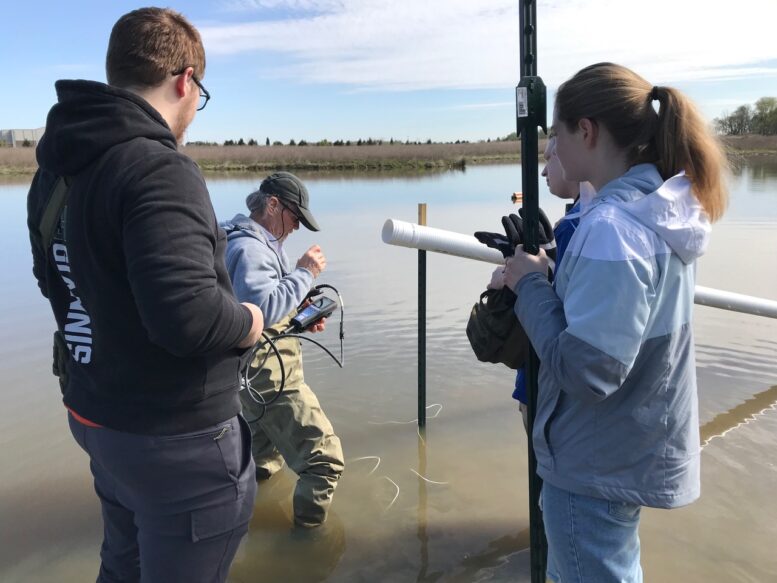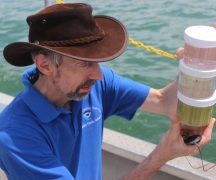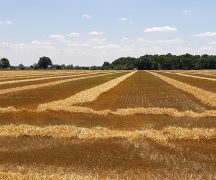By DAVID DUPONT
BG Independent News
A blue heron rises from the pool as the research team approaches. Red-wing blackbird calls ring out. It is an early May morning in Hancock County just south of Liberty Benton High School, about 60 miles from the shore of Lake Erie.
The researchers from Bowling Green State University led by Professor Emeritus Bob Midden are here as a part of a project to find some part of the solution for the harmful algal blooms that plague the western basin of the lake every summer.
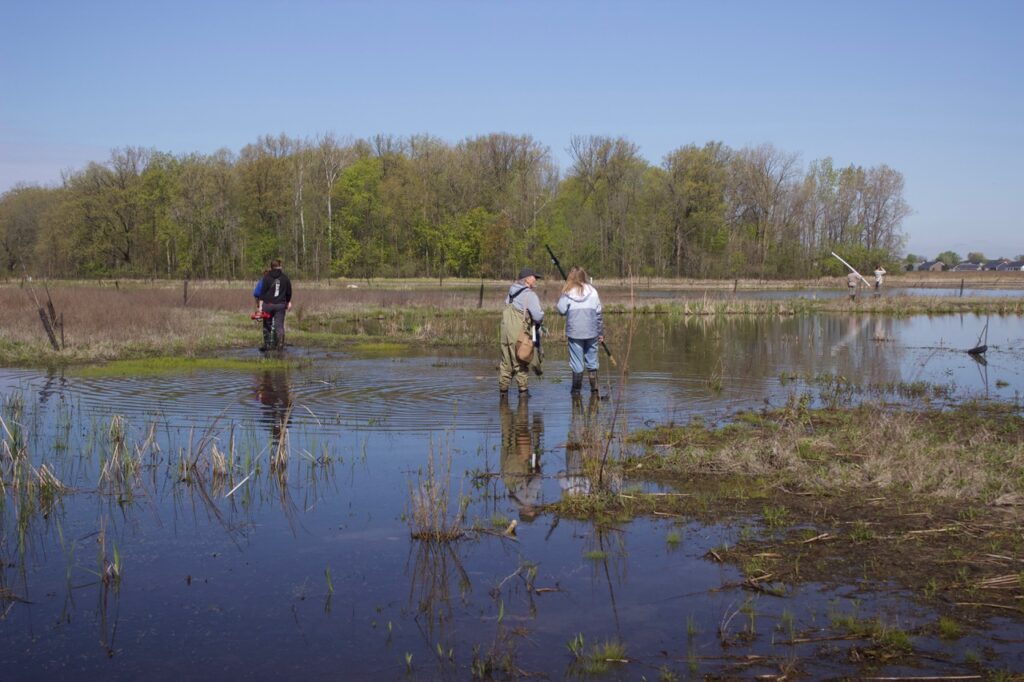
The blooms are larger or smaller depending largely on weather conditions. And as happened July 2014, they can turn deadly. The bloom is fueled in large part by water that runs off farm fields. That water is ladened with nitrogen and phosphorus, essential minerals for growing corn, soy, wheat, and other crops. It also passes through the digestive systems of animals raised for meat and milk. Rain washes it into the Maumee River and then to Lake Erie. In the lake, that phosphorus and nitrogen feed the algae.
Midden has focused much of his research on projects aimed at finding remedies for the bloom. No one approach will work, he said. “There’s nothing that’s going to accomplish it all. Wetlands by themselves aren’t going to do it all nor will changing all the agricultural practices nor will fixing all the septic systems nor will improving the removal of phosphate from wastewater systems nor will reducing the amount of phosphate that people apply to their lawns,” he said. “But by doing it all we stand a fighting chance of reducing the harmful agal blooms to an acceptable level.”
Wetlands are referred as the kidneys of the landscape. They can hold the nitrogen and phosphorus in run off. But questions remain about how wetlands process those chemicals. This research is seeking the answers.
“The ultimate goal is to develop wetlands based on these studies,” Midden said.
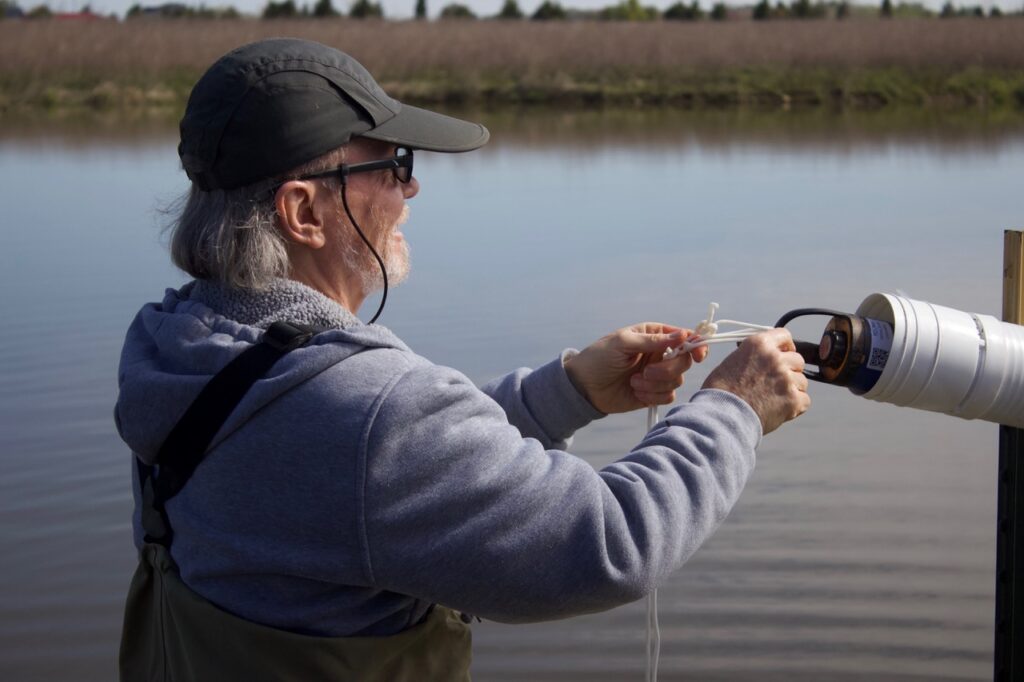
The sondes are devices placed into the wetlands floating about a foot from the bottom. The devices collect data every 15 minutes. That data could help researchers get a clearer picture about how wetlands work and how to help them better filter agricultural runoff.
On this early May morning, Midden and the team members wade hip deep to place sondes in two ponds. The Oakwood Natural Preserve is one of the 120 wetlands being studied as part of the H2Ohio initiative. The bottom is uneven and mucky, sucking on the bottom of their boots. In one pond, only Midden ventures out, treading carefully to avoid full immersion in the pond.
In April, Midden took part in a BGSU Science Cafe that addressed the study of wetlands.
Harmful algal blooms are, he explained, a worldwide problem, occurring anywhere crops are grown. They also can be caused by natural sources.
They are “a serious threat to our economy ecology and our health,” Midden said.
Their devastating effects are evident just south of Bowling Green in Grand Lake Saint Marys. Once a thriving tourist destination, it is now severely impaired.
The fear of such a fate for Lake Erie led the state of Ohio to launch the $110 million multi-agency H2Ohio initiative. Of that money, $4.3 million is devoted an independent scientific effort to evaluate the effectiveness of these wetlands for achieving the goal of reducing the amount of phosphorus and nitrogen reduction. Achieving that goal is complicated, Midden explained.
Phosphorus and nitrogen sequestered in a wetland disperse into the atmosphere in different ways. Nitrogen can turn into a gas, the largest component of the earth’s atmosphere. “That completely eliminates the problem of the nitrate in the water,” he said.
A different mechanism is at play with phosphorus in a wetland. Phosphate is removed mostly by sticking to minerals to soil especially minerals that contain iron, aluminum, and manganese.
The phosphorus is held by plants, that can carry the mineral deeper into the soil. That phosphorus though can be released when the plants decompose.
So, plants, Midden said, are not considered a long-term storage. However, he said, they can hold the phosphorus during the critical period, from March through July, when run-off contributes to algal blooms.
“That’s when the plants are growing, so if the plants can take it out of circulation during that period, they can make a contribution, even if they die and release it back into the water in October, November, December, January,” he said.
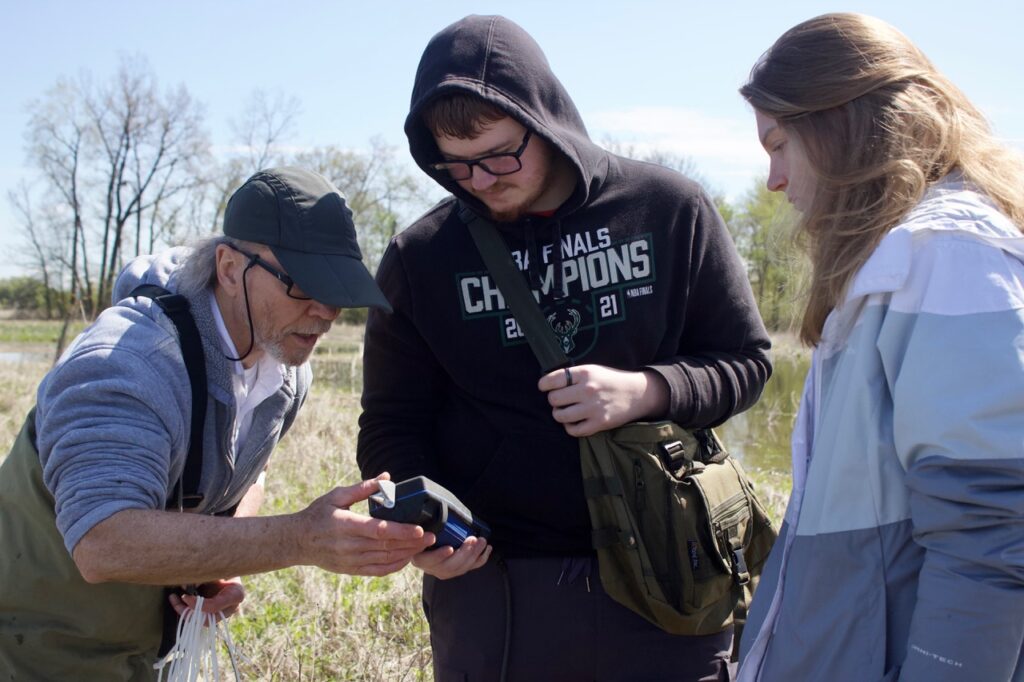
In May, Midden with Genna Hunt, the field research manager, and field research assistants Lucy Busselle and Xavier Decoursey with two Hancock Park District employees are placing the sondes. They must be removed in winter because the devices, which cost $7,000 each, can’t tolerate freezing temperature.
These two ponds have benefits as research sites. While the water is several feet deep in May, the ponds will dry up through the summer, so researchers know where the lowest spots are. That’s the best location for the sondes allowing the collection of data for a longer period.
While the water comes in through five field tiles, there’s no outflow. “What it takes in, it keeps,” Midden said.
Each sonde has four probes, he explained. One measures the measures the pH in the water to determine how acidic it is. Another measures the concentration of oxygen that’s dissolved in the water.
A third measures how easily electricity passes through the water. That can give an approximation of how much matter is dissolved in the water. “The more stuff dissolved, typically the more contaminated it is,” Midden said. Also, “the electrical conductivity can allow us to distinguish between water that’s coming from underground and water that’s coming from above ground water” as well as water that’s been in the wetlands for a while. Usually the electrical conductivity declines as water sits in the wetlands.
The sondes also measure turbidity or cloudiness of the water as well as the temperature. They also determine how much phosphorus and ammonia have dissolved.
Every four to six weeks members of the research team will collect water and soil samples from the sites to be analyzed in the lab to determine the total amount of nitrogen and total amount of phosphorus.
Busselle, a chemistry major, has grant from the university’s Center for Undergraduate Research and Scholarship to analyze those samples, and expects to present findings a year from now.
Midden has also studied possible solutions from another angle. He and colleagues also developed ways to remove much of the moisture from animal waste produced in large animal feeding operations. This would allow it to be transported greater distances and spread more evenly and in lesser quantities as fertilizer over a greater area.
[RELATED: Midden & colleagues explore ways to put manure from large livestock operations to good use]
“We demonstrated that it is successful on a small scale at the Northwest Ohio Agricultural Research Station,” Midden said. “It’s ready now for prototyping at full farm scale. … I even have a design for that, but I’m not interested in trying to start a business.”
The team working on it sought state assistance “but the Ohio Department of Agricultural doesn’t seem real keen on it. Without their support and backing difficult to get the funding from the state to do the prototype scale.”
A couple of start-ups have shown interest as have others involved in the issue.
As for Midden: “I like doing science and learning new stuff. That is more of an engineering project now, taking what we know works and scaling it up to the size of a farm and multiple farms.”

